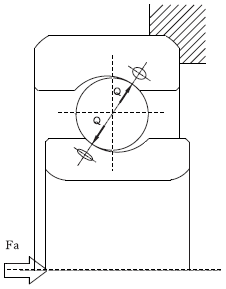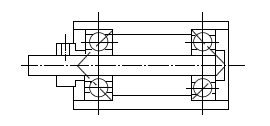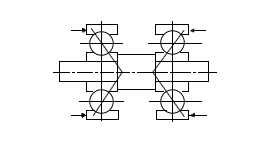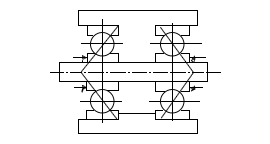The purpose of applying a preload to a ball bearing is to improve the runout precision of the rotating shaft , and to reduce vibration and noise. However, if the preload amount and preload method are not properly selected, bearing performance such as life, noise and heat generation may be degraded, and/or vibration may increase. Therefore, it is important to select the proper amount of preload and method for each application.
The purpose of preload

If there is any internal clearance in a ball bearing, the balls will have more play, the stiffness of the ball bearing will be minimal, and the vibration levels of the shaft will increase. Therefore, internal clearance needs to be adjusted to zero by applying an axial load (Fa) as shown in the figure 12-1. This load , applied in the axial direction, is called the preload, and reduces vibration and noise.
It is not enough to apply the appropriate preload method; the magnitude of preload should also be selected carefully to the required performance of the ball bearing.
If the preload is applied excessively, the bearing stiffness will increase. However, bearing life will be shorter, and bearing noise will increase as well. If the applied preload is insufficient, fretting damage could occur due to vibration and low bearing stiffness. Therefore, selecting the appropriate preload is an important factor when considering the performance of a ball bearing.
Optimum preload
If the preload is the dominant load applied to the bearing, MinebeaMitsumi recommends an optimum preload based on the "surface stress" calculation, which focuses on noise life.
When the preload (Fa) is applied to the ball bearing, a small contact ellipse is generated as a result of elastic deformation of the contact areas between balls and raceways. The surface stress is calculated by dividing the loads (rolling element load: Q) which are generated in the perpendicular direction at the contacts between the balls and raceways, by the surface areas (S) of the contact ellipses. In figure 12-1, the contact ellipse area (S) between the balls and raceways is formulated as
S = πab(mm2),where the ratio of circumference is π, the major axis is a and the minor axis is b.
Also, if the average surface stress is P,
P = Q/S (MPa).
See below for the noise life guideline.
Over 10,000 hours noise life requirement
The specific preload should not generate an average surface contact stress (P) higher than 800Mpa.
5,000 - 10,000 hours noise life requirement (general products)
The specific preload should be generating an average surface contact stress (P) of roughly 1000MPa.
Less than 5,000 hours noise life requirement (critical stiffness application)
The specific preload should be generating an average surface contact stress (P) of roughly 1500MPa.
Simple calculation of the preloads by using dynamic load rating (Cr)
Over 10,000 hours noise life requirement : 0.5/100·Cr - 1/100·Cr
5,000 - 10,000 hours noise life requirement : 1/100·Cr - 1.5/100·Cr
Less than 5,000 hours noise life requirement : 1.5/100·Cr - 2/100·Cr
Maximum permissible load
In the case of high carbon chromium bearing steel, it is said that if the average surface stress exceeds 2,700 MPa, it will enter the plastic deformation region. Even if the loads are applied for very short time, the loads should not generate more than 2700MPa of average surface stress. From experience, we recommend applying loads which do not generate more than 1600MPa of average surface stress.
Besides preload, other types of loads should also be considered because they could generate surface stress.
Preload and stiffness
There are two methods of preloading: "fixed position preload" (Figure 12-2) and "constant pressure preload" (Figure 12-3).
・Fixed position preload
This is a method for applying preload based on the positional relationship between parts. The advantages are simplicity and high stiffness of the components. However, expansion and shrinkage of the components due to temperature change occasionally can cause changes in preload. The components could also wear out, and eventually the preloads could be reduced.
・Constant pressure preload
Constant pressure preload can be applied by using a coil spring, a spring wave washer, and so on. An advantage of spring preload is a stable preload despite temperature variation. The disadvantages are complexity and low stiffness.
The preload can be applied in two directions: Duplex face to face (DF) (Figure 12-4) and duplex back to back (DB) (Figure 12-5).
・Duplex face to face (DF)
Since the intersection of the contact angles is inward, it has the disadvantage of poor rigidity, but the tolerance for mounting errors will be large. Duplex face to face may be selected in consideration of the structure of the application and the simplification of the assembly process.
・Duplex back to back (DB)
The rigidity is high as the intersection of the contact angles is open outward. In order to improve rigidity, it is necessary to control the component precision at the same time.
Preload method

Figure 12-2 Fixed position preload

Figure 12-3 Constant pressure preload
Preload direction

Figure 12-4 Duplex face to face (DF)

Figure 12-5 Duplex back to back (DB)
Related page
Engineering Information for Miniature & small ball bearings
Selecting the Right Part
Technical Data
Contact Us
Please click the inquiry type below according to your question. Each product / sales representative will respond to you.